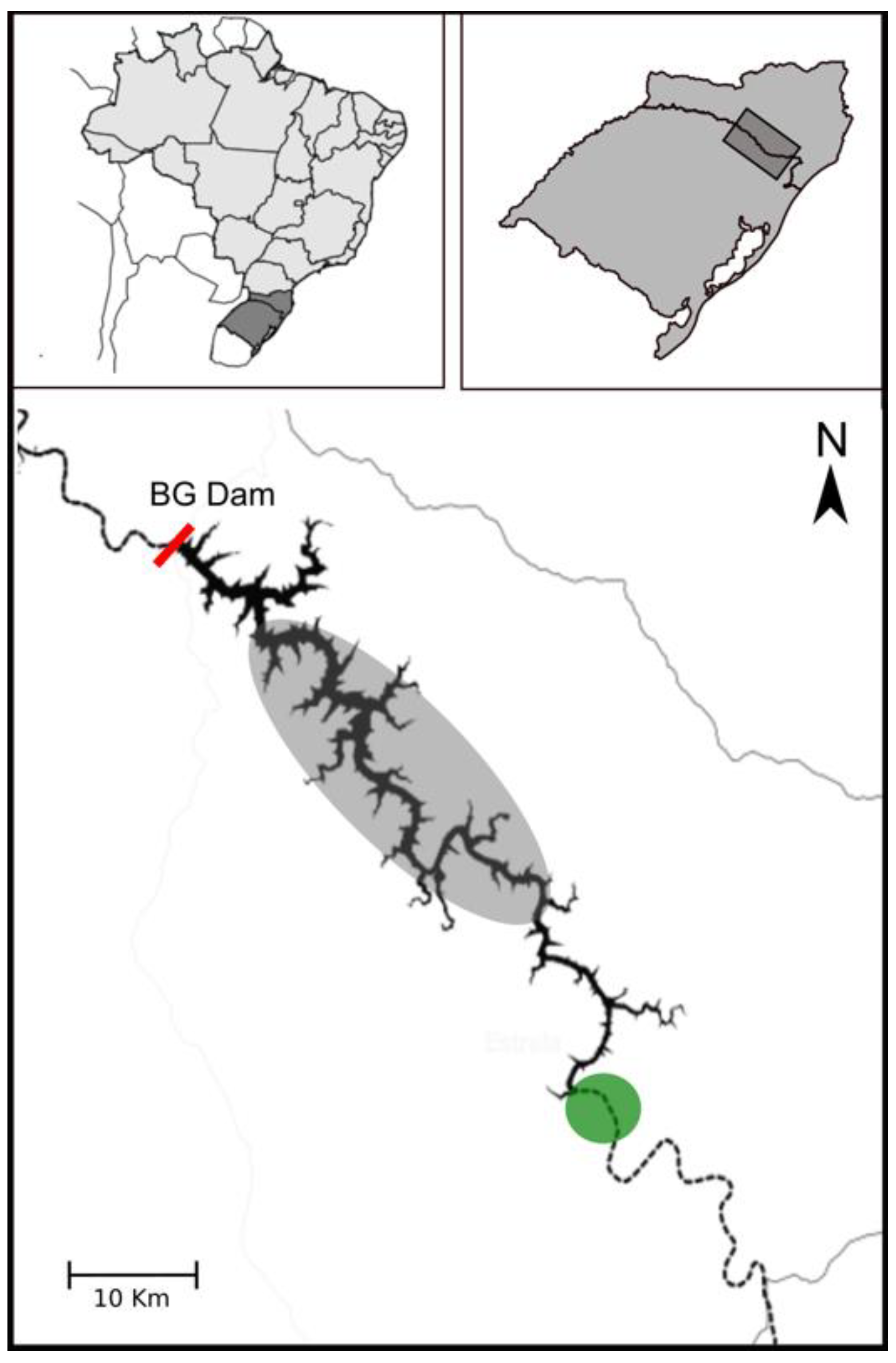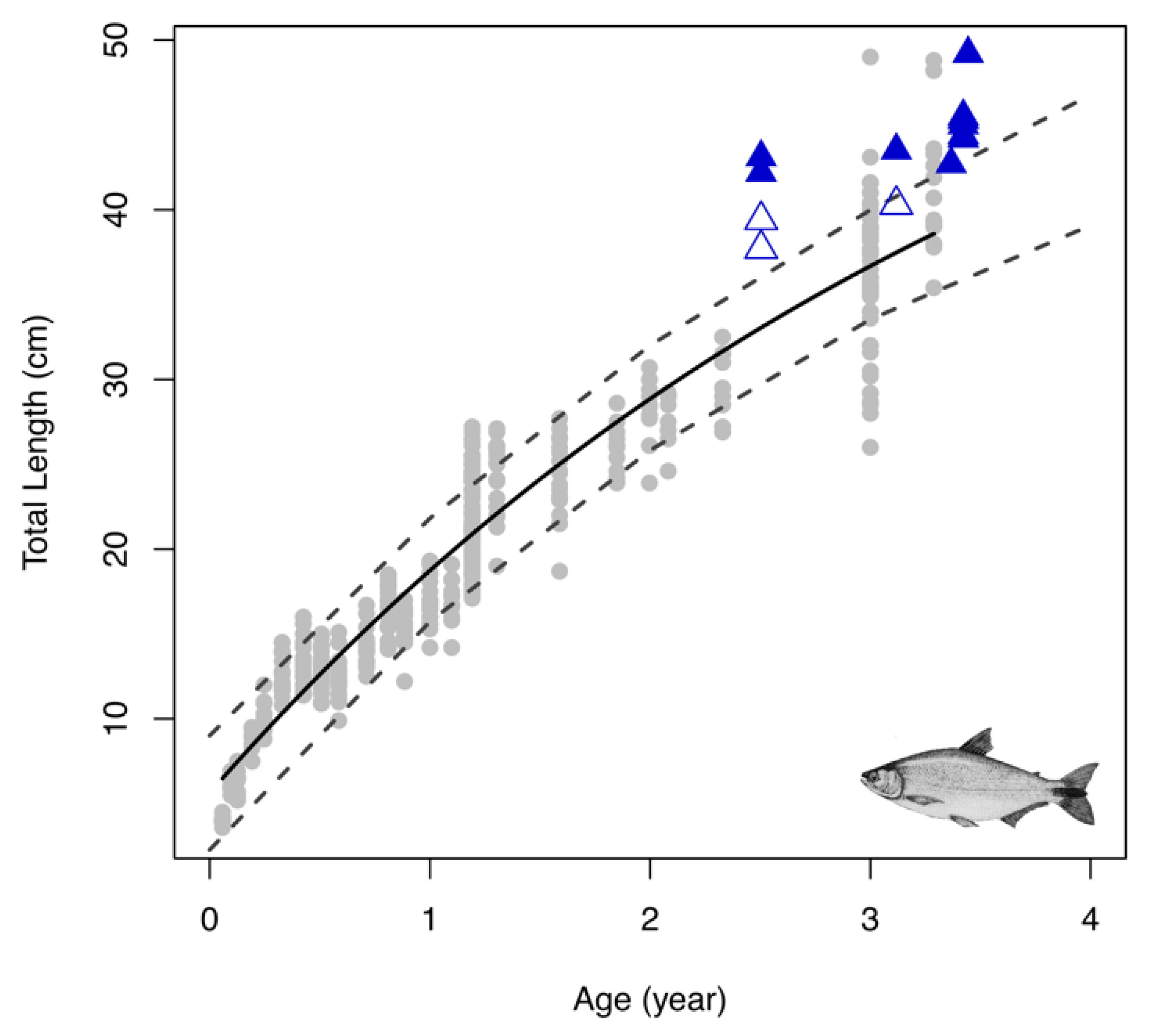Assessing the Viability of Reintroduction of Locally Extinct Migratory Fish Brycon orbignyanus: Successful Growth, Dispersal and Maturation
Abstract
:1. Introduction
2. Results
3. Discussion
4. Materials and Methods
4.1. Study Area
4.2. Source of Fish
4.3. Release and Post-Release Monitoring
4.4. Control Population
4.5. Genetics
4.6. Growth Model
4.7. Regulatory and Ethical Compliance
5. Conclusions
Supplementary Materials
Author Contributions
Funding
Acknowledgments
Conflicts of Interest
References
- Liermann, C.R.; Nilsson, C.; Robertson, J.; Ng, R.Y. Implications of Dam Obstruction for Global Freshwater Fish Diversity. Bioscience 2012, 62, 539–548. [Google Scholar] [CrossRef] [Green Version]
- Agostinho, A.A.; Gomes, L.C.; Pelicice, F.M. Ecologia e Manejo Recursos Pesqueiros em Reservatórios do Brasil; EDUEM: Maringá, Brazil, 2007; pp. 253–274. [Google Scholar]
- Cochran-Biederman, J.L.; Wyman, K.E.; French, W.E.; Loppnow, G.L. Identifying Correlates of Success and Failure of Native Freshwater Fish Reintroductions. Conserv. Biol. 2015, 29, 175–186. [Google Scholar] [CrossRef] [PubMed]
- Holmlund, C.M.; Hammer, M. Ecosystem Services Generated by Fish Populations. Ecol. Econ. 1999, 29, 253–268. [Google Scholar] [CrossRef]
- Petchey, O.L.; Gaston, K.J.; Building, A.D.; Bank, W.; Sheffield, S. Extinction and the Loss of Functional Diversity. Proc. R. Soc. Lond. B Biol. Sci. 2002, 269, 1–7. [Google Scholar] [CrossRef] [PubMed]
- Winemiller, K.O.; McIntyre, P.B.; Castello, L.; Fluet-Chouinard, E.; Giarrizzo, T.; Nam, S.; Baird, I.G.; Darwall, W.; Lujan, N.K.; Harrison, I.; et al. Balancing Hydropower and Biodiversity in the Amazon, Congo, and Mekong. Science 2016, 351, 128–129. [Google Scholar] [CrossRef] [PubMed] [Green Version]
- Molony, B.W.; Lenanton, R.; Jackson, G.; Norriss, J. Stock Enhancement as a Fisheries Management Tool. Rev. Fish Biol. Fish. 2005, 13, 409–432. [Google Scholar] [CrossRef]
- Lyon, J.P.; Todd, C.; Nicol, S.J.; MacDonald, A.; Stoessel, D.; Ingram, B.A.; Barker, R.J.; Bradshaw, C.J.A. Reintroduction Success of Threatened Australian Trout Cod (Maccullochella macquariensis) Based on Growth and Reproduction. Mar. Freshw. Res. 2012, 63, 598–605. [Google Scholar] [CrossRef]
- Ebner, B.C.; Thiem, J.D. Monitoring by Telemetry Reveals Differences in Movement and Survival Following Hatchery or Wild Rearing of an Endangered Fish. Mar. Freshw. Res. 2009, 60, 45–57. [Google Scholar] [CrossRef]
- Brown, C.; Day, R.L. The Future of Stock Enhancements: Lessons for Hatchery Practice from Conservation Biology. Fish Fish. 2002, 3, 79–94. [Google Scholar] [CrossRef]
- Pelicice, F.M.; Azevedo-Santos, V.M.; Vitule, J.R.S.; Orsi, M.L.; Lima Junior, D.P.; Magalhães, A.L.B.; Pompeu, P.S.; Petrere, M.; Agostinho, A.A. Neotropical Freshwater Fishes Imperilled by Unsustainable Policies. Fish Fish. 2017, 18, 1119–1133. [Google Scholar] [CrossRef]
- Zaniboni-Filho, E.; Schulz, U.H. Migratory fishes of the Uruguay River. In Migratory Fishes of South America: Biology, Fisheries and Conservation Status; Carosfeld, J., Harvey, B., Ross, C.V., Baer, A., Eds.; The World Bank, International Development Centre: Ottowa, ON, Canada, 2003; pp. 157–194. [Google Scholar]
- De Godoy, M.P. Peixes Do Estado de Santa Catarina; Universidade Federal de Santa Catarina: Florianópolis, SC, USA, 1987. [Google Scholar]
- Schork, G.; Hermes-Silva, S.; Zaniboni-Filho, E. Analysis of Fishing Activity in the Itá Reservoir, Upper Uruguay River, in the Period 2004–2009. Braz. J. Biol. 2013, 73, 559–571. [Google Scholar] [CrossRef] [PubMed]
- Costa-Pereira, R.; Galetti, M. Frugivore Downsizing and the Collapse of Seed Dispersal by Fish. Biol. Conserv. 2015, 191, 809–811. [Google Scholar] [CrossRef]
- Agostinho, A.; Gomes, L.; Suzuki, H.; Julio, H. Migratory Fishes of the Upper Paraná River Basin, Brazil. In Migratory Fishes of South America: Biology, Fisheries and Conservation Status; Carosfeld, J., Harvey, B., Ross, C.V., Baer, A., Eds.; The World Bank, International Development Centre: Ottowa, ON, Canada, 2003; pp. 19–98. [Google Scholar]
- De Oliveira, D.J.; Ashikaga, F.Y.; Foresti, F.; Senhorini, J.A. Conservation Status of the “Piracanjuba” Brycon orbignyanus (Valenciennes, 1850) (Characiformes, Bryconidae): Basis for Management Programs. Biodivers. Bras. 2017, 7, 18–33. [Google Scholar]
- Ashikaga, F.Y.; Orsi, M.L.; Oliveira, C.; Senhorini, J.A.; Foresti, F. The endangered species Brycon orbignyanus: Genetic analysis and definition of priority areas for conservation. Environ. Biol. Fish. 2015, 98, 1845–1855. [Google Scholar] [CrossRef]
- Brown, G.E.; Smith, R.J.F. Acquired Predator Recognition in Juvenili Rainbow Trot (Oncorhynchus mykiss): Conditioning Hatchery-Reared Fish to Recognize Chemical Cues of a Predator. Can. J. Fish. Aquat. Sci. 1998, 55, 611–617. [Google Scholar] [CrossRef]
- Todd, C.R.; Lintermans, M. Who Do You Move? A Stochastic Population Model to Guide Translocation Strategies for an Endangered Freshwater Fish in South-Eastern Australia. Ecol. Model. 2015, 311, 63–72. [Google Scholar] [CrossRef]
- Zhang, L.; Jiang, W.; Wang, Q.J.; Zhao, H.; Zhang, H.X.; Marcec, R.M.; Willard, S.T.; Kouba, A.J. Reintroduction and Post-Release Survival of a Living Fossil: The Chinese Giant Salamander. PLoS ONE 2016, 11, 1–15. [Google Scholar] [CrossRef] [PubMed]
- Armstrong, D.P.; Seddon, P.J. Directions in Reintroduction Biology. Trends Ecol. Evol. 2008, 23, 20–25. [Google Scholar] [CrossRef] [PubMed]
- Masuda, R.; Tsukamoto, K. Stock Enhancement in Japan: Review and Perpective. Bull. Mar. Sci. 1998, 62, 337–358. [Google Scholar]
- Svåsand, T.; Kristiansen, T.S.; Pedersen, T.; Salvanes, A.G.V.; Engelsen, R.; Naevdal, G.; Nødtvedt, M. The Enhancement of Cod Stocks. Fish Fish. 2000, 1, 173–205. [Google Scholar] [CrossRef]
- Vazzoler, A.E.; Suzuki, H.I.; Marques, E.E.; Lizama, M.D. Primeira Maturação Gonadal, Periodos E Areas de Reprodução. In A Planície de Inundação do alto Rio Paraná—Aspectos Físicos, Biológicos e Socioeconômicos; Vazzoler, A.D., Agostinho, A.A., Hahn, N.S., Eds.; EDUEM: Maringá, Brazil, 1997; pp. 249–265. [Google Scholar]
- Ringuelet, R.A.; Arámburu, R.H.; Alonso de Arámburu, A.S. Los Peces Argentinos de Agua Dulce; Dirección de Conservación de la Fauna de la Provincia de Buenos Aires: Buenos Aires, Argentina, 1967. [Google Scholar]
- Bearlin, A.R.; Schreiber, E.S.; Nicol, S.J.; Starfield, A.M.; Todd, C.R. Identifying the Weakest Link: Simulating Adaptive Management of the Reintroduction of a Threatened Fish. Can. J. Fish. Aquat. Sci. 2002, 59, 1709–1716. [Google Scholar] [CrossRef]
- Todd, C.R.; Nicol, S.J.; Koehn, J.D. Density-Dependence Uncertainty in Population Models for the Conservation Management of Trout Cod, Maccullochella macquariensis. Ecol. Model. 2004, 171, 359–380. [Google Scholar] [CrossRef]
- Woynarovich, E.; Horváth, L. The Artificial Propagation of Warm-Water Finfishes: A Manual for Extension; Food and Agriculture Organization of the United Nations: Rome, Italy, 1980. [Google Scholar]
- Lopera-Barrero, N.M. Conservation of Brycon Orbignyanus Natural Populations and Stocks for Their Reproductive, Genetic, Environmental Sustainability: A Model for Species Threatened with Extinction. Ciencia e Investigación Agraria 2009, 36, 191–208. [Google Scholar] [CrossRef]
- Wallace, M.P. Retaining natural behaviour in captivity for reintroduction programmes. In Behaviour and Conservation; Gosling, L.M., Sutherland, W.J., Eds.; Cambridge University Press: Cambridge, UK, 2000; pp. 300–314. [Google Scholar]
- IUCN/SSC. Guidelines for Reintroductions and Other Conservation Translocations; Version 1.0; IUCN/SSC: Gland, Switzerland, 2013. [Google Scholar]
- Olla, B.L. Behavioural Deficits in Hatchery-Reared Fish: Potential Effects on Survival Following Release. Aquac. Fish. Manag. 1994, 25, 19–34. [Google Scholar]
- Vazzoler, A.E.A.D.M. Manual de Métodos Para Estudos Biológicos de Populaçoes de Peixes: Reproduçao E Crescimento; CNPq: Brasília, Brazil, 1981. [Google Scholar]
- Vazzoler, A.E.A.D.M. Biologia Da Reprodução de Peixes Teleósteos: Teoria E Prática; EDUEM: Maringá, Brazil, 1996. [Google Scholar]
- Tolussi, C.E.; Wagner, A.; Hilsdorf, S.; Caneppele, D.; Guimarães Moreira, R. The Effects of Stocking Density in Physiological Parameters and Growth of the Endangered Teleost Species Piabanha, Brycon insignis (Steindachner, 1877). Aquaculture 2010, 310, 221–228. [Google Scholar] [CrossRef]
- Lopera-Barrero, N.M.; Povh, J.A.; Ribeiro, R.P.; Gomes, P.C.; Jacometo, C.B.; Silva Lopes, T.D. Comparación de Protocolos de Extracción de ADN Con Muestras de Aleta Y Larva de Peces: Extracción Modificada Con Cloruro de Sodio. Ciencia e Investigación Agraria 2008, 35, 77–86. [Google Scholar] [CrossRef]
- Barroso, R.M.; Hilsdorf, A.W.S.; Moreira, H.L.M.; Mello, A.M.; Guimaraes, S.E.F.; Cabello, P.H.; Traub-Cseko, Y.M. Identification and Characterization of Microsatellites Loci in Brycon opalinus (Cuvier, 1819) (Characiforme, Characidae, Bryconiae). Mol. Ecol. Notes 2003, 3, 297–298. [Google Scholar] [CrossRef]
- Excoffier, L.; Smouse, P.E.; Quattro, J.M. Analysis of molecular variance inferred from metric distances among DNA haplotypes: Application to human mitochondrial DNA restriction data. Genetics 1992, 131, 479–491. [Google Scholar] [PubMed]
- Peakall, R.; Smouse, P.E. GenAlEx 6.5: Genetic Analysis in Excel. Population Genetic Software for Teaching and Research—An Update. Bioinformatics 2012, 28, 2537–2539. [Google Scholar] [CrossRef] [PubMed]
- Von Bertalanffy, L. A quantitative theory of organic growth (inquiries on growth laws. II). Hum. Biol. 1938, 10, 181–213. [Google Scholar]
- R Core Team. R: A Language and Environment for Statistical Computing; R Foundation for Statistical Computing: Vienna, Austria, 2017. [Google Scholar]
- Ogle, D.H. FSA: Fisheries Stock Assessment Methods; R Package FSA Version 0.8.20; R Package: Madison, WI, USA, 2018. [Google Scholar]


| Parameter | Estimated | L95% | U95% |
|---|---|---|---|
| L∞ | 59 | 56.04 | 74.56 |
| K | 0.3 | 0.199 | 0.316 |
| t0 | −0.36 | −0.46 | −0.29 |
© 2018 by the authors. Licensee MDPI, Basel, Switzerland. This article is an open access article distributed under the terms and conditions of the Creative Commons Attribution (CC BY) license (http://creativecommons.org/licenses/by/4.0/).
Share and Cite
Esquivel-Muelbert, J.R.; Fontoura, L.; Zardo, É.; Streit, D.P., Jr.; Esquivel-Muelbert, A.; Garcia, J.R.E. Assessing the Viability of Reintroduction of Locally Extinct Migratory Fish Brycon orbignyanus: Successful Growth, Dispersal and Maturation. Fishes 2018, 3, 39. https://doi.org/10.3390/fishes3040039
Esquivel-Muelbert JR, Fontoura L, Zardo É, Streit DP Jr., Esquivel-Muelbert A, Garcia JRE. Assessing the Viability of Reintroduction of Locally Extinct Migratory Fish Brycon orbignyanus: Successful Growth, Dispersal and Maturation. Fishes. 2018; 3(4):39. https://doi.org/10.3390/fishes3040039
Chicago/Turabian StyleEsquivel-Muelbert, Juan R., Luisa Fontoura, Éverton Zardo, Danilo P. Streit, Jr., Adriane Esquivel-Muelbert, and Juan R. E. Garcia. 2018. "Assessing the Viability of Reintroduction of Locally Extinct Migratory Fish Brycon orbignyanus: Successful Growth, Dispersal and Maturation" Fishes 3, no. 4: 39. https://doi.org/10.3390/fishes3040039





